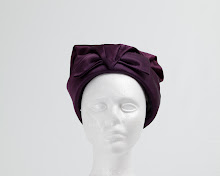I am starting to do the actual cataloging of the hats now. This means writing the physical descriptions, measuring them, noting condition issues, how they were acquired and anything I might know about previous owners. The last one is very easy.
I know almost nothing about the former owners of any of hats. This is actually very sad in many ways. Like the good art history major that I am, I know the importance of provenance. Provenance is the ownership chain of a given item (painting, book, car, hat). I want to know about the owners of these hats. I want to know where they were worn, why they were bought. Was the purple hat a special occasion hat? Did the owner wear it to a wedding or a christening? Was it a church hat? I can see the owner of the faux fur felt with the leopard spots wearing it to go shopping downtown in a sharp black two piece coat and dress, with the coat having a collar matching the hat and black gloves and a black leather handbag slung over her left arm. Shopping and lunch—at the Miller and Rhodes Tea Room of course, with a stop at the Amethyst Room afterward, to look at more Sara Sue hats. That sharp white fir Suzon probably made its debut at a North Carolina Symphony concert in Memorial Auditorium during the winter. That is the only time of the year that it gets cold enough in Raleigh to wear fur. The yellow net and flower hat was worn with a matching dress (perhaps by Raleigh’s premier dressmaker, Willie O. Kay) I am sure for Easter Sunday services at Christ Church or Church of the Good Shepard, both in downtown. The black felt whimsy with the netting (which is datable to the late 1940s from the label style) was, I am sure, the talk of a cocktail party, worn with a black sheath cocktail dress. This hat, which is what we would probably now call a fascinator, was included in an exhibit at the Gallery of Art and Design at North Carolina State University about the history of the little black dress. I give my hats their histories in my mind since I know nothing about their previous owners. I am throwing caution to the wind as I recreate the world of my hats.
Archival descriptions are so clinical. Type of material, dimensions, construction, labels, condition. It sounds more like one is writing in a medical chart rather than describing an article of clothing. Still, archival descriptions are important, because you need to know how to properly care for, store, and display the item being described. If you store it correctly, it will be around for a long time for more people to enjoy. That is why it breaks my heart to think of the number of hats and other items of clothing that have wound up in the dustbin. I have to confess to looking at obituaries in the paper and thinking, “wow, I bet she owned a whole lot of nice clothes and hats.” I know, it is wrong of me to do that. I just cannot help it.
I did the same thing, creating fantasy worlds for vintage clothes, when we were closing Raleigh Creative Costumes. We were selling the vintage clothes, which had come from a variety of sources over the years. RCC had sort of become Raleigh’s attic for the clothes of the recently deceased. Which is probably how some of my hats wound up at various vintage stores. I think the phone conversation went like this “Aunt So and So died. Quick bring her clothes to Doug at Raleigh Creative. I am sure she could use them for shows.” Some of the stuff that was in the back needed to go to dustbin, alas, because while I am sure it was fantastic when it was new, now it was beyond repair. Years of being worn, then being in a clothes closet or bureau, and then in storage, is not always good for garments, hats or shoes. After researching the clothes with labels, figuring out prices, and taking measurements the clothes went out into the sales area. As I was looking at them I would talk to them, you know, converse, ask them questions like “so, did you like the play you saw when you were first worn?” “You gave Irving a bond for his Bar Mitzvah like a good Gramma, right?” I created histories for the dresses. I think my favorite was the hostess gown, a filmy blue polyester number from the 1960’s. The owner was a hostess at an Italian restaurant, owned by her brother-in-law. They gave her the job after her husband left her for his secretary—she needed the work and they needed the help. I even saw her hairstyle in mind. Tall, with wisps framing her face and light blue eye shadow. I am the Clothes Whisperer. It is indeed an honor.
The thankless task of description writing continues. So do the fantasies!
